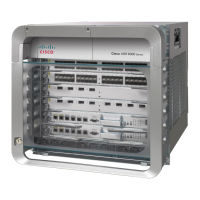116
Cisco ASR 9000 Series Aggregation Services Router Getting Started Guide
OL-28417-02
Chapter CLI Tips, Techniques, and Shortcuts
Displaying System Information with show Commands
show command | file filename
This feature enables you to save any of the show command output in a file for further analysis and
reference. When you choose to redirect command output, consider the following guidelines:
• If the full path of the file is not specified, the default directory for your account is used. You should
always save your target configuration files to this location.
• If the saved output is to be used as a configuration file, the filename should end with the cfg suffix
for easy identification. This suffix is not required, but can help locate target configuration files.
Example:
myconfig.cfg
In the following example, a target configuration file is saved to the default user directory:
RP/0//CPU0:router# configure
RP/0//CPU0:router(config)# show configure | file disk0:myconfig.cfg
RP/0//CPU0:router(config)# abort
RP/0//CPU0:router#
Narrowing Output from Large Configurations
Displaying a large running configuration can produce thousands of lines of output. To limit the output
of a show command to only the items you want to view, use the procedures in the following sections:
• Limiting show Command Output to a Specific Feature or Interface, page 116
• Using Wildcards to Display All Instances of an Interface, page 117
Limiting show Command Output to a Specific Feature or Interface
Entering keywords and arguments in the show command limits the show output to a specific feature or
interface.
In the following example, only information about the static IP route configuration appears:
RP/0//CPU0:router# show running-config router static
router static
address-family ipv4 unicast
0.0.0.0/0 10.21.0.1
0.0.0.0/0 /1/0/1 10.21.0.1
!
!
In the following example, the configuration for a specific interface appears:
RP/0//CPU0:router# show running-config interface 0/1/0/1
interface /1/0/1
ipv4 address 10.21.54.31 255.255.0.0
!
Using Wildcards to Display All Instances of an Interface
To display the configuration for all instances, enter the asterisk (*) wildcard character.
Note For more information, see the “Using Wildcards to Identify Interfaces in show Commands” section on
page 124.

